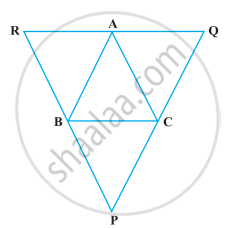Advertisements
Advertisements
Question
A square is inscribed in an isosceles right triangle so that the square and the triangle have one angle common. Show that the vertex of the square opposite the vertex of the common angle bisects the hypotenuse.
Solution
Given: In isosceles triangle ABC, a square ΔDEF is inscribed.
To prove: CE = BE
Proof: In an isosceles ΔABC,
∠A = 90°
And AB = AC ...(i)
Since, ΔDEF is a square.
AD = AF [All sides of square are equal] ...(ii)
On subtracting equation (ii) from equation (i), we get
AB – AD = AC – AF
BD = CF ...(iii)
Now, in ΔCFE and ΔBDE,

BD = CF ...[From equation (iii)]
DE = EF ...[Sides of a square]
And ∠CFE = ∠EDB ...[Each 90°]
ΔCFE ≅ ΔBDE ...[By SAS congruence rule]
∴ CE = BE ...[By CPCT]
Hence, vertex E of the square bisects the hypotenuse BC.
APPEARS IN
RELATED QUESTIONS
`square`ABCD is a parallelogram, P and Q are midpoints of side AB and DC respectively, then prove `square`APCQ is a parallelogram.

ABCD is a rhombus in which altitude from D to side AB bisects AB. Find the angles of the rhombus.
Through A, B and C, lines RQ, PR and QP have been drawn, respectively parallel to sides BC, CA and AB of a ∆ABC as shown in the following figure. Show that BC = `1/2` QR.

